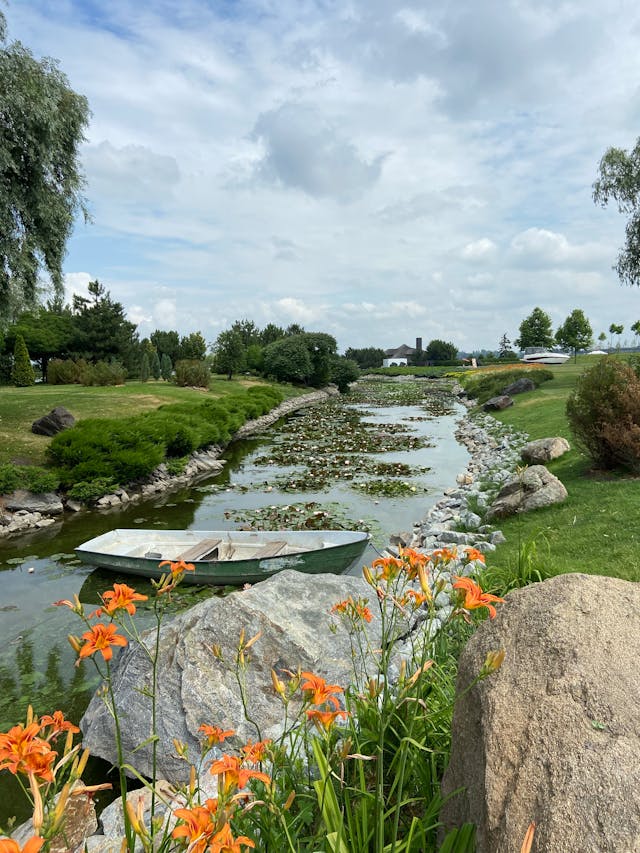Healing gardens are not a new notion, but they are worth reconsidering as evidence of the benefits of outdoor space grows. The volume of searches for relaxing garden ideas and how to soundproof a garden demonstrate that we are all just wanting to create our own small outdoor refuge.
Mindful gardening is one method to utilize nature to enhance your well-being, but being outside offers several additional mental health advantages. According to Mind, including nature into your daily life may enhance your mood, decrease stress and aggression, make you feel more calm, boost your confidence, and alleviate loneliness.

Visiting public green areas is lovely, and these parks are vital lifelines for individuals who do not have their own outdoor space, but having your own garden will allow you to interact with nature more often.
Furthermore, the mental health advantages may be enhanced by creating a garden centered on the notion of ‘healing’. But what exactly is a ‘healing’ garden, and how do you go about building one?
What is a healing garden?
“A healing garden is a space that should make people feel better,” says landscape designer Harriet Worsley of Worsley Design & Consultancy. ‘They do not have to be unwell or in pain. It might just be a peaceful, pleasant green place that helps to improve the mood of individuals who engage with it.
Healing gardens are not new. The concept may be traced back to zen gardens, which have been in Japanese culture for over 1000 years, or cloister gardens, which were located in many medieval monasteries and utilized by monks as locations for peaceful reflection.
What are the key qualities of a therapeutic garden healing?
Trees
Have you heard of forest bathing? The word first appeared in Japan in the 1980s as a physiological and psychological workout known as shinrin-yoku, and it has lately been adopted by millennial health seekers in the West.
Some believe that trees emit phytoncides, which are antimicrobial substances that, when inhaled, boost the formation of white blood cells known as natural killer (NK) cells, which destroy tumor- and virus-infected cells in our bodies.
A 2010 research discovered that NK activity following a three-day, two-night woodland bathing vacation lasted more than 30 days.
According to interior designer Paula Robinsion, author of The therapeutic Home and Garden (Yellow Kite), this is why trees are essential in any therapeutic garden, even if they are little. Paula specifically advises “evergreens like cedar, pine, spruce, and conifer” since they create the greatest phytoncides.
Where to Purchase Small Garden Trees:
Crocus: This online garden center offers a variety of tiny trees, including acers and eucalyptus.
B&Q: Buy 10 2ft cedar trees for £55.
Ponds
Small garden with a lengthy water feature and a chair.
Following green space, a healing garden will seek to integrate aspects of blue space via a garden water feature design.
‘Consider constructing a pond, no matter how little,’ suggests Paula. ‘Proximity to blue space is incredibly helpful to human health, and it benefits animals by providing a vital clean water supply.’
The research behind this feature is solid: a meta-review of 20 studies looking at population-level links between blue spaces and human health found that the more time individuals spent near water, the better they felt.
Spaces for wildlife healing
Chelsea garden, with bird cages constructed onto the wall.
The following two characteristics of a healing garden are concerned with conserving the natural ecosystem and not disrupting the equilibrium that nature has established.
‘When we create a connection with our land and the animals who live on it, we heal ourselves,’ Paula says. Include at least one bird feeder. Watching and listening to birds helps us calm down and improves our stillness abilities, which leads to better health.
Native grasses
A home is surrounded by lush grass and meadow flowers.
And, just as it is crucial to make room for yourself and animals to thrive, particular care should be taken to foster native plants and grasses.

‘Instead of a lawn, go for short, wild native grasses, with wild native herbs and clover to attract bees, butterflies, and dragonflies,’ Paula advises.
A simple method to do this is to plant wildflowers instead of grass seed, using a wildflower seed mix like this one for £10 on Amazon.
Sensorial experience
A black water tub shown at the RHS Chelsea Flower Show.
Harriet believes that a therapeutic garden should incorporate a variety of sensory garden ideas to excite all of the senses, including sight, sound, touch, and scent.
‘Visually, it must excite, and a background of green foliage and a shifting tapestry of flowers throughout the year evokes wonder and hope.
The sounds include the rustling of bamboo or Betula leaves, birds chirping, and gentle running water. are relaxing, and may serve to block out or distract from an overhead aircraft path or rush hour traffic.
‘Raised beds with plants with soft and tactile leaves may also be beneficial for people who may reach out and touch the plants or brush past them.’
How to Create Your Own Healing Garden
1. Go native.
House with wildflowers
With its focus on allowing nature to do its magic, it’s no wonder that rewilding plays an important role in establishing your own healing garden. If you’re going to introduce plants from outside into your garden, Paula suggests doing some study and searching for species that you’d ordinarily find in your area.
Paula recommends using a mix of books, plant identification apps, and regional databases to identify species local to your area. ‘Avoid exotic and imported plants. Non-native species are often invasive, do not sustain indigenous insect and animal populations, and destabilize the native ecology.
2. Avoid straight lines.
Chelsea Garden Show 2023: Cottage Garden Ideas
Nothing should be overly severe or ordered in a healing garden, and you should avoid harsh edges and straight lines. ‘Curved lines are gentler on the eyes and reduce irritation,’ adds Paula.
In addition, it is a good idea to keep hardscaping, such as a concrete walkway or brick wall, to a minimum. Most gardens will have some hardscaping, but if you’re designing a healing garden, Paula recommends keeping it to a minimum. When you do, aim to utilize recycled and sustainable materials that benefit the local fauna.
3. Create meandering routes.
A winding route with light slate stones and shingle, bordered by alliums and agapanthus
Garden walkway ideas are essential for a healing garden, as are garden seating ideas. They are the locations where you can slow down and enjoy the garden you’ve made.
‘Consider all of the senses, and design meandering pathways and plenty of seating so that the garden plan causes you to stop and stroll leisurely, taking in the fragrance, sound, flowers, and mood.’
4. Soften the lighting.
Wooden sitting area with fireplace.
Lighting, like that in our beds and houses, may have a significant impact on our mood. For example, Paula advises red or amber garden lights. Lights4Funs’ flame effect garden lanterns, available at £20, are ideal for creating a calming light in the evening.
‘Avoid blue and white LED lights, since they alter human circadian cycles and pose huge problems for the ecology.’

6. Avoid pesticides.
“Don’t use pesticides for the sake of your health and the planet,” Paula cautions.
A ‘pesticide’ is an agent that prevents, eliminates, or regulates a hazardous organism or disease, as well as protects plants or plant products. According to the World Health Organization, “pesticides are potentially toxic to humans and can have both acute and chronic health effects, depending on the quantity and modes of exposure.” They are definitely not healing.
FAQs
What purpose does a healing garden serve?
The phrase “healing” is often associated with hospitals, hospices, and treatment centers. However, Harriet claims that “anyone can benefit from healing elements in an outdoor space.” So, all a healing garden has to accomplish is provide a feeling of serenity. That is its primary responsibility.
‘Most individuals will feel boosted by being in a peaceful garden and connecting with nature,’ Harriet says. ‘Some of the most soothing outdoor areas I’ve ever been to were in gardens surrounding monasteries and temples, like the Namgyal Monastery in Dharmasala and the monastery at Paleokastritsa on Corfu. It’s the tranquil atmosphere I associate with a therapeutic garden.
What are the colors of a healing garden?
Green is the hue we most connect with nature, and it goes without saying that a healing garden should be planted in the shade. Then it’s a matter of accenting that green with colors that complement and relax.
‘White against green can be really serene,’ explains Harriet, ‘and white flowers look fantastic at nightfall. They nearly shine as the day passes. Bright colors are stimulating and optimistic, whilst pastel colors seem tranquil and romantic. There are no optimum colors, but the goal is to keep to a color palette that avoids unnecessary conflicts. Plan the colors ahead of time to ensure that they all complement one another.
Grey stone walkway, concrete construction.
What are the finest plants for a healing garden?
Natives are the greatest, because anything that engages the senses
‘I would always add a variety of evergreens so that the beds do not seem sparse in the winter,’ Harriet advises. Grasses work well because they rustle and move in the wind, adding vitality in January and February before being chopped down.
‘Something in blossom for each season is essential, as are plants with strong scents such as wisteria, jasmine, and honeysuckle. I would also put soft leaves near paths rather than spikes or thorns.’
Above all, avoid overthinking things. A therapeutic garden isn’t accomplishing its purpose if it causes you more stress. ‘Let your intuition direct you to the herbs that will be most therapeutic for you,’ explains Paula.

